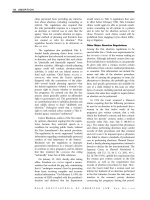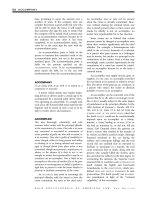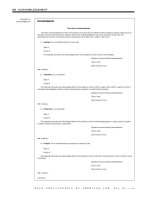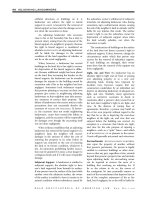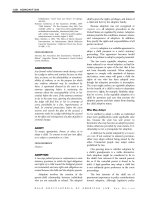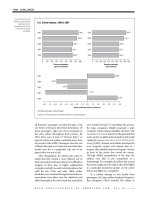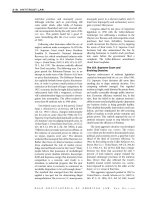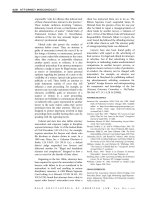Gale Encyclopedia Of American Law 3Rd Edition Volume 4 P8 pot
Bạn đang xem bản rút gọn của tài liệu. Xem và tải ngay bản đầy đủ của tài liệu tại đây (516.88 KB, 10 trang )
and for civil liberties. During her life she worked
to improve working conditions for U.S. laborers,
helped establish the
AMERICAN CIVIL LIBERTIES UNION
(ACLU), and lobbied for the enactment of the
EQUAL RIGHTS AMENDMENT.Inmanyofherexploits
she partnered with her younger brother Max.
Max Eastman gained fame as a Marxist writer
and journalist who later rejected
SOCIALISM and
became a supporter of the virulently anti-
communist senator,
JOSEPH MCCARTHY.Incon-
trast, Crystal Eastman was a consistent supporter
of socialist politics, the suffragist movement, and
feminism throughout her life.
Eastman was born on June 25, 1881, in
Glenora, New York, to Samuel Eastm an and
Annis Ford Eastman. Both her parents were
ordained church ministers and ardent believers
in women’srights,beliefsthatEastman
absorbed. In a 1927 autobiographical essay
written for Nation magazine, E astman talked
about her father’s support of her mother’sgoal
of becomin g a m inister and his support of
Crystal when she decided to study law. He even
supported the rebellious Crystal when she led
her teenage friends in revolt against the
wearing of skirts and stockings as part of the
swimming attire of proper young l adies. Her
father knew that he would not want to wear a
skirt and stockings when he went swimming,
shewrote,sohecouldseewhyhisdaughter
would not want to either. Eastman also
credited her mother with encouraging Crystal
and her two brothers to be independent
thinkers and to advocate for the causes that
were most important to them.
Eastman graduated from Vassar College in
1903 and earned a master’s degree in sociology
from Columbia University in 1904. She attended
New York City School of Law where she
graduated second in her class in 1907. Until
1911, Eastman lived in a Greenwich Village
commune that included her brother Max.
Paul Kellogg, social work advocate and
editor of a publication called Charities and the
Commons, hired the young attorney as part of a
team charged with investigating conditions
among steel workers in Pittsburgh, Pennsylva-
nia. The resulting survey, published between
1909 and 1914, was a groundbreaking six-
volume study that was the first to combine the
collection of scientific data with management
techniques. Eastman’s portion of the survey, a
report titled Work Accidents and the Law, was
published in 1910. The report, which focused
on unsafe working environments and the
corruption of officials and others, was a startlin g
revelation to many politicians and citizens. In
1909 Eastman became the first woman
appointed to the Employer’s Liability Commis-
sion. In that role she drafted the first workers’
compensation law for the state of New York.
Eastman married Walter Benedict and moved
to Milwaukee, Wisconsin, where she continued
be involved in women’s suffrage issues. Eastman
eventually separated from her husband and
moved back to New York where she became an
investigating attorney for the U.S. Commission
on Industrial Relations in 1913. That same year,
Eastman, along with suffragist
ALICE PAUL and
several others, helped to found the militant
Congressional Union for Woman Suffrage that
was a forerunner of the National Woman’s
Party. In 1915 Eastman joined over three
thousand women for a meeting in Washington,
Crystal Eastman 1881–1928
▼▼
▼▼
18751875
19251925
19001900
◆
◆
❖
◆
◆
◆
1881 Born,
Glendora, N.Y.
1914–18
World War I
1903 Graduated
from Vassar College
◆
◆
❖
◆
◆
◆
1920 Nineteenth Amendment ratified,
gave nationwide suffrage rights to women
1918 Palmer Raids target
left-wing political dissenters
1912 Congress passed eight-hour
day labor law for federal employees
1904 Earned M.A. from Columbia University
1907
Graduated from
New York City
School of Law
1917–21
Editor of
The Liberator
magazine
1928 Died,
Erie, Pa.
1923 Authored Equal Rights
Amendment with Alice Paul
1910 Published Work Accidents and Laws
1913
Helped found
Congressional
Union for
Women
Suffrage
1916 Helped found National Civil Liberties Union
GALE ENCYCLOPEDIA OF AMERICAN LAW, 3RD E DITION
EASTMAN, CRYSTAL 59
D.C., where they founded the Woman’sPeace
Party with famed social worker
JANE ADDAMS as
chair. Eastman became president of the New
York branch of the party which, in 1921, was
renamed the Women’s International League for
Peace and Freedom. That organization, which
exists to this day, supports disarmament,
women’s rights, civil liberties, and
ABOLITION of
CAPITAL PUNISHMENT.
Eastman also served as executive director of
the American Union against Militarism
(AUAM), an organization that lobbied to keep
the United States from entering into war against
Mexico in 1916 and to support American
neutrality during
WORLD WAR I. Within the
AUAM, Eastman along with social reformers
ROGER BALDWIN and Norman Thomas established
a subsection called the National Civil Liberties
Bureau (NCLB) whose primary purpose was to
advocate for and protect the
BILL OF RIGH TS .
Eastman worked on the left-wing political
journal The Masses with her brother Max who
was editor. When that periodical was closed
down due to lawsuits, Eastman and her brother
joined with several others to found a similar
journal, The Liberator. Eastman was editor of
the magazine from 1917 to 1921. In 1922 The
Liberator was taken over by the Communist
Party, which later renamed it The Workers’
Monthly.
Eastman had always been a passionate
defender of free speech, but her support for
the concept strengthened in the face of the
suppression of antiwar activists during and
afterWorldWarI.PresidentWoodrow
Wilson’s attorney general A. Mitchell Palmer
and Palmer’s special assistant J. Edgar Hoover
used the
ESPIONA G E AC T O F 1917 and the 1918
Sedition Act to commence a campaign against
those perceived to be radic als or members of
left-wing organizations. Palmer and Hoover
conducted Palmer Raids, casting a large net
that involved the arrest, in over 30 cities
around the country, of thousands of suspected
anarchists and supporters of socialism and
COMMUNISM. Arrests were often made without
warrants and several hundred, including noted
feminist and radical
EMMA GOLDMAN,were
deported.
In 1920 the NCLB, which had been
established with the aim of protecting the Bill
of Rights against encroachments such as those
encompassed by the Palmer Raids, became
the American Civil Liberties Union (ACLU).
The purpose of the organization was to advo-
cate for
FIRST AMENDMENT rights including
FREEDOM OF SPEECH, freedom of RELIGION, and
FREEDOM OF THE PRESS, as well as EQUAL PROTECTION
and due process rights, and the right to privacy.
In 2003 the ACLU, which remains headquar-
tered in New York City, had grown from a
roomful of activists to an organization with over
300,000 members, and supporters and offices all
over the country.
In the 1920s Eastman traveled between
New York and London where her second
husband, British poet and peace activist Walter
Fuller, had gone to look for work. During this
period she worked as a journalist, writing
columns for several U.S. periodicals including
the Nation and Alice Paul’s Equal Rights, and
British publications such as the Daily Herald
and a British feminist weekly called Time and
Tide.
Shortly after women gained the right to
vote, Eastman, along with Alice Paul, became
one of the authors of the Equal Rights
Amendment (ERA), which proposed amend-
ing the U.S. Constitution to invalidate numer-
ous state and federal laws that discriminated
against women while purporting to “protect”
them. No action was taken on the ERA when it
was introduced in Congress in 1923, and it
languished until 1966 when the
NATIONAL
ORGANIZATION FOR WOMEN
(NOW) revived
interest in it. The amendment was approved
by Congress in 1972 and given a seven-year
deadline for ratification by 38 states. The
amendment was ratified by 30 states within
one year of S enate approval. But opposition
from conservative political and religious
groups halted the m omentum. Despite an
extension of the deadline to 1982 and ratifica-
tion by five more states, the amendment failed
to be ratified by the required three-fourths and
did not become law.
After her husband’s death in 1927, Eastman
returned to live permanently in the United
States. She died just one year later, in July 1928,
at her brother’s home in Erie, Pennsylvania. She
was 48 years old. In 2000 Eastman, along with
19 other distinguished American women, was
inducted into the National Women’s Hall of
Fall in Seneca Falls, New York, the birthplace of
the women’s rights movement.
I AM NOT
INTERESTED IN
WOMEN JUST
BECAUSE THEY
’RE
WOMEN
.IAM
INTERESTED
,
HOWEVER, IN SEEING
THAT THEY ARE NO
LONGER CLASSED
WITH CHILDREN AND
MINORS
.
—CRYSTAL EASTMAN
GALE ENCYCLOPEDIA OF AMERICAN LAW, 3RD E DITION
60 EASTMAN, CRYSTAL
FURTHER READINGS
Cook, Blanche Wiesen. 1993. “Radical Women of Green-
wich Village.” In Greenwich Village: Culture and
Counterculture, edited by Rick Beard and Leslie
Berlowitz Cohen. Newark N.J.: Rutgers Univ. Press.
Cook, Blanche Wiesen, ed. 1976. Toward the Great Change:
Max and Crystal Eastman on Feminism, Antimilitarism,
and Revolution. New York: Garland.
Kerber, Linda K., and Jane Sherron DeHart, eds. 2003.
Women’s America: Refocusing the Past. 6th ed. New
York: Oxford Univ. Press.
v
EATON, DORMAN BRIDGMAN
Dorman Bridgman Eaton was born June 27,
1823, in Hardwick, Vermont. He was a
successful lawyer who achieved prominence
for his work in the establishment of the U.S.
CIVIL SERVICE Commission.
After receiving a doctor of laws degree from
the University of Vermont in 1848, Eato n
attended Harvard Law School in 1850 and was
admitted to the New York bar, practicing law
there until 1870.
Eaton was a staunch believer in a merit
system as opposed to a spoils system in the
acquisition of local or national government
employment. In 1873 he became the chairper-
son of the U.S. Civil Service Commission, an
organization that embodied the ideas of the
merit system. He served until 1875, when
funding for the commission ceased, and he
subsequently went to England to examine the
structure of the English Civil Service Commis-
sion. In 1883, he formulated the Pendleton Act
(5 U.S.C.A. § 1101 et seq. [1883]), which
provided for the foundation of the permanent
Civil Service Commission. He performed the
duties of chairperson of this new commission
from 1883 to 1886. Eaton died December 23,
1899, in New York City.
In 1880, Eaton wrote the publication The
Civil Service in Great Britain: A History of Abuses
and Reforms and their Bearing upon American
Politics.
ECCLESIASTICAL COURTS
In England, the collective classification of particu-
lar courts that exercised jurisdiction primarily over
Dorman B. Eaton.
LIBRARY OF CONGRESS
Dorman Bridgman Eaton 1823–1899
❖
❖
1823 Born,
Hardwick, Vt.
1850 Graduated from Harvard Law School;
admitted to New York bar
1873–75 Served as chair of the U.S. Civil Service Commission
1899 The Government of
Municipalities published;
died, New York City
1861–65
U.S. Civil War
◆
1883–86 Served as chairman of the
Civil Service Commission
1850–70 Practiced
law in New York
1886 Returned to New York City to
work on municipal government reform
▼▼
▼▼
18751875
19001900
18251825
18501850
◆
◆
◆
1880 The Civil Service in Great Britain: A History of Abuses and Reforms and
their Bearing upon American Politics published
1883 Formulated the Pendleton Act, basis for U.S. civil service system
GALE ENCYCLOPEDIA OF AMERICAN LAW, 3RD E DITION
ECCLESIASTICAL COURTS 61
spiritual matters. A system of courts, held by
authority granted by the sovereign, that assumed
jurisdiction over matters concerning the ritual and
religion of the established church, and over the
rights, obligations, and discipline of the clergy.
ECONOMIC BAILOUT
An economic bailout is a plan through which the
government provides financial assistance to trou-
bled industries and companies, often during times
of national economic crisis.
At many times throughout U.S. history,
companies and other entities have sought
economic assistance during different crises.
Most of this assistance has come from the
government, though in some instance s, private
entities have also been involved. Turbulent
economic periods have often been marked
with instances of government bailouts. Such
periods include the Great Depression during
the 1930s, the recession of the mid-1970s, the
savings and loan crisis of the 1980s and 1990s,
and the difficult economic periods of the
2000s.
Government bailouts often cause controver-
sy, especially when entities have been accused of
mismanagement. During 2008 and 2009, several
financial institutions, as well as the three largest
automobile makers in the United States, were
on the verge of
BANKRUPTCY. Although the
declining economic condition hastened these
near-collapses, some analysts and commenta-
tors believed that the companies were in poor
economic health because of poor management
as much anything else. Critics of government
bailout programs often note that the free
market system in the United States demands
that companies face the risk of failure. Eco-
nomic bailouts generally shift the risk of failure
to taxpayers. Plus, some critics characterize
bailout programs as something more like a
system of
SOCIALISM than part of a system of
capitalism.
Despite these criticisms, economists argue
that bailouts are necessary because the collapse
of certain important entities, including those in
the transportation and financial sectors, could
lead to a more widespread collapse of the
economy in general. Moreover, studies have
shown that the government typically earns its
money back with interest when it devotes funds
to struggling companies. Though bailouts are
seldom popular with the public, especially when
the companies seeking assistance are accused of
poor management, the bailouts have saved a
number of businesses and other entities
throughout U.S. history.
History
Bailouts are nothing new in U.S. history. In
1791 the U.S. government assumed debts that
several states owed as a result of the American
Revolutionary War. The government’s assump-
tion of these obligations increased the national
debt but also spurred a market for debt
SECURITIES. New York businessman William
Duer developed a plan to bring down the stock
prices of the Bank of New York so that he could
take control of the bank. Duer also planned to
corner the market on certain types of govern-
ment bonds. His plan led to a sharp decrease in
the value of the government bonds. The
collapse in the bond value led to a sharp decline
in
REAL ESTATE values, which could have led to a
massive depression.
ALEXANDER HAMILTON was the Treasury secre-
tary and one of the founders of the Bank of New
York. Hamilton devised a plan in which the
TREASURY DEPARTMENT bought bonds by borrow-
ing money from the banks. This action
increased the value of the bonds. Hamilton also
instructed banks to accept bonds as collateral
for loans that the banks made to securities
brokers, and the government guaranteed this
collateral. The result of Hamilton’s actions was
that the Bank of New York did not collapse, and
the United States did not fall into a major
depression. In fact, no bank in the United States
failed until 1809.
History has seen a number of other banking
panics. A notable panic occurred in 1907, when
several banks and trusts had made loans for an
attempt to corner the market on stock in a
copper company. When that attempt failed,
confidence in the banks and trusts waned,
leading depositors to withdraw their capital.
The Treasury Department attempted to inter-
vene by injecting millions into the banking
system. However, it was the actions of banker J.
Pierpont Morgan that helped to resolve the
crisis. He worked with several bankers to create
a joint pool of capital that could be used to save
banks that were at risk of collapse. One result
from the panic in 1907 was the creation of the
Federal Reserve System, which was designed to
GALE ENCYCLOPEDIA OF AMERICAN LAW, 3RD E DITION
62 ECONOMIC BAILOUT
create a lender of LAST RESORT for U.S. financial
institutions.
The Great Depression of the 1930s led many
homeowners to default on their mortgages. By
1933, banks were foreclosing on nearly one
thousand homes per day. President
FRANKLIN D.
ROOSEVELT and Congress responded by creating
the Home Owners’ Loan Corporation, which
purchased defaulted mortgages from the banks
and then refinanced the mortgages at lower,
fixed rates. The agency issued mortgages to
about one million homeowners. By the time the
agency dissolved in 1951, more than 80 percent
of the borrowers had repaid their mortgages on
time or early. Lee Davison, a historian with the
FEDERAL DEPOSIT INSURANCE CORPORATION, noted
that the p rogram earned the government a small
profit. “You save 80 percent of the people from
being tossed o ut of their homes, and it di dn’tend
up costing the government a dollar,” he said.
Several companies during the 1970s and
1980s sought government assistance when they
faced collapse. These companies included Penn
Central Railroad in 1970, Lockheed in 1971,
Franklin National Bank in 1974, Chrysler in
1980, and Continental Illinois National Bank
and
TRUST COMPANY in 1984. In several of these
instances, the companies repaid the government
loans, and the government earned interest from
these loans and otherwise recouped funds
through other transactions.
One of the more costly bailouts involved the
savings and loan industry. During the 1980s,
savings and loan institutions started investing
heavily in commercial real estate. By the mid-
1980s, though, interest rates had risen, and
the savings and loan institutions were paying
more in interest to their depositors than they were
earning from their loans. Betwee n 1986 and 1995,
about half of the more than 3,200 savings and loan
institutions in the Unite d States closed, leaving
federal insurers with billions in b ad debt.
In 1989 Congress enacted the Financial
Institutions Reform Recovery and Enforcement
Act of 1989 (Pub. L. No. 101-73, 103 Stat. 194).
This act authorized $293.8 billion in financing
for folding savings and loan institutions. The act
also created the Resolution Trust Corporation,
which was responsible for making depositors
whole and for investigating wrongdoing in the
savings and loan industry. The savings and loan
crisis eventually cost taxpayers an estimated
$124 billion.
Bailouts of the First Decade of the 2000s
Several different kinds of bailouts occurred in
the early 2000s.
Airlines Even before the terrorist attacks on
the United States in 2001, the airline industry
was suffering financially. Analysts estimated
before September 11, 2001, that airlines would
lose $2 billion in 2001. After those terrorist
attacks, the government ordered all airplanes in
the United States to be grounded, thus causing
greater losses in the airline industry.
Eleven days after the terrorist attacks,
Congress approved and President
GEORGE W.
BUSH signed the Air Transportation Safety and
System Stabilization Act (Pub. L. No. 107-42,
115 Stat. 230). This act provided $5 billion in
direct relief to the airlines and also included $10
billion in loan guarantees. Other provisions
included tax relief, insurance, and limited
liability to certain air carriers.
The airline bailout plan allowed the Trea-
sury Department to purchase stock at prices
below market for any air line that received a loan
guarantee. Although the loan guarantee pro-
gram suffered a loss when one of the minor
airlines filed for bankruptcy, the government
earned at least $140 million from its acquisition
of stock in the airlines.
Subprime Lending Crisis The 1990s saw a
boom in the issuance of what is known as
subprime lending. Lenders initially targeted
those with impaired credit or no credit for the
types of loans offered within the category of
subprime loans. The most common of these
loans has been the adjustable rate loan, under
which a mortgage begins at a certain rate but
which the mortgage company can change
depending on the market situations. Other
types of subprime loans include, for example,
interest-only loans and zero-down loans involv-
ing more than one mortgage company (also
known as piggy-back loans).
Although these subprime loan packages can
help some homeowners to purchase houses that
these homeowners would not be able to
purchase otherwise, many who took out sub-
prime loans ran into unforeseen problems. In
most instances, mortgage companies will in-
crease the rates of adjustable rate mortgages.
Thus, a borrower may be able to afford the
initial rate of, for example, 7 percent interest,
but when the lender increases the rate to
GALE ENCYCLOPEDIA OF AMERICAN LAW, 3RD E DITION
ECONOMIC BAILOUT 63
8 percent, the borrower has more difficulty
paying. As the percentage continues to increase,
the borrower’s ability to pay is progressively
weakened. Similar problems arise with interest-
only loans and zero-down loans with piggy-
backs, the terms of which tend to favor
mortgage companies and not the borrowers.
To make matters worse, many of the subprime
lenders did not require borrowers to show proof
of income.
Prime loans have remained the most preva-
lent, representing 80 percent of the total
mortgages in the United States as of 2010.
However, subprime loans became increasingly
popular even for those with a sufficient credit
history to qualify for a conventional loan. In
many cases, the rate of a subprime loan
(especially an adjustable rate mortgage) initially
may have been less than a conventional loan.
However, when the mortgage companies in-
creased those rates, the rate of the subprime
loan surpassed the rate of the conventional loan.
Between 2001 and 2006, the percentage of new
loans characterized as subprime or near-prime
rose substantially.
Between 2002 and 2005, housing prices had
steadily increased, which helped the subprime
loan market. Companies also continued to ease
their credit standards. Moreover, interest rates
during this time remained low as a result of the
Bailout of the American
Auto Industry
F
or most of the twentieth century,
the U.S. auto industry was domi-
nated by the “Big Three” of Detroit:
General Motors, Ford Motor Company,
and Chrysler. The Big Three sold most of
the automobiles in the American market,
in the process becoming central to the
U.S. manufacturing economy. Unioniza-
tion of the companies in the 1930s led to
high wages and benefits for union work-
ers. However, problems began to develop
in the 1970s, as imported cars began to
enter the market and labor disputes with
the United Auto Workers (UAW) esca-
lated. The federal government intervened
in 1979 to keep Chrysler afloat, and the
industry rebounded. By 2005, Japanese
auto companies commanded a large
share of the U.S. market. The loss of
sales eventually drove the Big Three to
the brink of collapse in 2008. The U.S.
government again intervened, this time
by loaning billions to General Motors
and Chrysler. As of the end of 2009, it
was unclear whether these efforts would
ultimately save these companies.
The federal loan of $1.5 billion to
Chrysler in 1979 saved the company.
During the 1980s the Big Three again
prospered, due in large part to Congress
exempting truck-based vehicles—pick-
ups, SUVs, and minivans—from fuel-
economy regulations. Japanese and other
foreign automakers initially did not try to
compete with these sectors of the market,
which left Detroit in the driver’s seat.
Though these truck-based vehicles were
not fuel efficient, the price of oil dropped
steadily through the 1990s; sales in these
sectors became the most profitable for
Detroit.
By 2000, the Big Three were making
record profits and building their cash
reserves. Pickups accounted for large
profit margins, whereas smaller cars
produced no profit and sometimes
losses. This trend started to crack when
oil prices began to rise in 2001. Con-
sumers began to look at more fuel-
efficient autos, which reduced the de-
mand for trucks and SUVs. In response,
Detroit began closing factories and laying
off workers, yet this was not enough. In
the spring of 2008, gas prices increased
dramatically, rising to over $4 per gallon.
Consumers panicked and stopped buying
pickups and SUVs. Then, in September
2008, the
STOCK MARKET and some finan-
cial institutions collapsed, driving the
United States into a recession. Auto sales
dropped over 30 percent in October,
forcing the Big Three to spend their cash
reserves on parts, labor, and other
overhead.
Realizing that their existence was in
danger, the Big Three asked the federal
government in September for loan guar-
antees so that they could retool their
plants to produce more fuel-efficient
cars. The request generated political
controversy, as federal intervention went
against free market ideas. Moreover,
critics pointed out that many businesses
were suffering from the recession, yet
they could not obtain federal relief. The
automakers and the UAW, along with
some economists, responded that the
auto industry was a linchpin of the U.S.
economy. If the automakers went bank-
rupt, more auto workers would be added
to the unemployment lines, and the
ripple effect would take down many of
the companies that supplied parts and
other services to Detroit.
General Motors By the end of
November, General Motors announced
it would run out of money in early 2009
and be forced to close if it did not receive
federal assistance. On December 20, 2008,
GALE ENCYCLOPEDIA OF AMERICAN LAW, 3RD E DITION
64 ECONOMIC BAILOUT
recession of 2001. During this period, when
many borrowers had difficulty making their
mortgage payments, borrowers often had a few
options. In many cases, borrowers could borrow
against their homes through home equity loans
to make mortgage payments. Borrowers could
also sell their homes to settle their mortgage
debts. Lenders took these circumstances into
account when the lenders continued to market
these subprime loans aggressively.
A variety of factors caused subprime lenders
to begin to experience heavy losses. First, home
prices in 2006 began to decline, meaning that
borrowers lost equity in their homes. In many
cases, subprime borrowers owed more on their
mortgages than their homes were now worth,
meaning that the borrowers had few options
when they could not make their payments.
Delinquency rates of subprime loans issued in
2006 greatly exceeded the rates of 2004.
In April 2007 one of the nation’s largest
subprime lenders, New Century Financial, filed
for bankruptcy. By the summer of 2007,
Bear Sterns announced that it had experienced
huge losses as a result of its subprime mortgage
holdings. Bear Sterns had been one of the
world’s largest investment banks and securities
and brokerage firms, but by 2008 the firm was
in ruins. In March 2008 the Federal Reserve
orchestrated the acquisition of Bear Sterns by
the Bush administration loaned General
Motors $15.4 billion in three payments.
Thegovernmentorderedthecompanyto
submit a plan in February 2009 that
would explain how it could restore itself
to long-term profitability. To make this
plan work, the UAW had to agree to cuts
in benefits, and suppliers and creditors
had to agree to make concessions. If the
government approved the plan, it would
continue to loan General Motors money.
The plan th at General Motor s
submitted dramatically altered the size
of the company. It proposed t o cut
47,000 jobs out of a total w orldwi de
workforce of 244,00 0 by the end o f
2009. The Obama administration
rejected the plan in late March, giving
the c ompany another 60 days to gain
concessions from unions and bond-
holders. A White House taskforce told
the company more job cuts were needed
and that more brands would have to
eliminated. General Motors responded
with a plan in April that would e limi-
nate the Pon tiac, Saturn, and Hummer
brands, s hed 42 percent of its dealers,
close 13 plants, and layoff 21,000 jobs.
More job s would be cut in coming years.
Under the plan the federal government
would become majority owne r, in ex-
change for another $11 billion. General
Motors concluded that this plan would
allow it to break even.
In late May 2009 the UAW agreed to
concessions involving retiree benefits and
the funding of the retiree trust. However,
bondholders refused an offer that would
have traded their $27 billion debt in
return for 10 percent of the company.
Though the negotiations continued,
General Motors finally decided to file
for
BANKRUPTCY on June 1. It packaged all
its best assets into a new company called
General Motors Company and was able
to exit bankruptcy quickly. The federal
government owns 60 percent of the new
company, the Canadian government 12
percent, and the UAW 20 percent. The
Obama administration agreed to provide
$30 billion in additional financing,
bringing the total federal bailout money
for General Motors to $50 billion. By
November 2009, the company an-
nounced it was returning some of the
bailout money. Though it had reduced its
losses, the introduction of new vehicle
models in late 2009 and in 2010 would
be key to the future of the company.
Chrysler The financial and manage-
ment history of Chrysler has been
checkered. In 1998 the German auto-
maker Daimler-Benz merged with
Chrysler, but it soon became apparent
that Daimler had taken over the com-
pany. The marriage never worked out,
and in 2007, Daimler sold the U.S. assets
of DaimlerChrysler to Cerberus Capital
Management. Cerberus, a private equity
fund, had no luck in turning around the
fortunes of Chrysler. The smallest of the
Big Three, Chrysler sales fell 25 percent
in 2008, in large part because of its
reliance on selling pickup trucks and
SUVs.
Chrysler received a $4 billion loan in
December 2008 to avoid bankruptcy and
began negotiating with Italian automaker
Fiat to purchase a substantial part of the
company.
As with General Motors, negotiating
concessions from bondholders and hedge
funds proved difficult. Chrysler filed for
bankruptcy on April 30, 2009, and
emerged from it 42 days later. The
federal government paid $6.6 billion in
exit financing to Chrysler but required
the company to sell most of its assets to
Fiat. Chrysler closed plants, laid off
workers, and shuttered dealerships. It
was expected that smaller, fuel-efficient
Fiat models would be sold at Chrysler
dealerships.
The Ford Motor Company did not
ask for federal bailout money. The
company had begun to restructure in
2006. It introduced smaller, more fuel-
efficient vehicles in 2008 and improved
the quality of it products. By November
2009, the company reported increasing
sales. It also stated that its North
American units were profitable.
FURTHER READINGS
Harbour, James. 2009. Factory Man: How Jim
Harbour Discovered Toyota’s Quality
and Productivity Methods and Helped the
U.S. Auto Industry Get Competitive.
Dearborn, Mich.: Society of Manufactur-
ing Engineers.
GALE ENCYCLOPEDIA OF AMERICAN LAW, 3RD E DITION
ECONOMIC BAILOUT 65
JPMorgan Chase & Company. The Federal
Reserve agreed to finance up to $29 billion to
help JPMorgan to cover Bear Sterns’ losses. The
government’s action represented the first bail-
out of a broker since the Great Depression.
Several firms that had loaned money to Bear
Sterns experienced problems as a result of the
Bear Sterns collapse. These firms included
JPMorgan Chase, Merrill Lynch, Citigroup,
and Goldman Sachs.
The crisis continued in 2008. In February,
with the U.S. economy as a whole struggling,
President George W. Bush signed the Economic
Stimulus Act of 2008 (Pub. L. No. 110-185, 112
Stat. 613). The act injected $168 billion into the
economy over the course of two years. Howev-
er, the economy continued to suffer due to the
mortgage crisis. By 2008, agencies that rate the
value of securities reduced the ratings on $1.9
trillion in mortgage-backed securities. The
rating reductions had the effect of lowering
the stock value of several financial firms.
The situation appeared to hit rock bottom in
September 2008. Fannie Mae and Freddie Mac,
which owned or backed more than $5 trillion in
mortgages, had experienced billions in losses in
2007 and 2008. On September 6, 2008, Treasury
secretary Henry Paulson announced that the
government would take over those firms. The
Treasury Department also agreed to provide up
to $200 billion in loans to provide funding for
banks and other home lenders.
Several Wall Street firms also reached the
point of collapse in September 2008. Insurance
company American International Group (AIG)
suffered more than $18 billion in losses during a
nine-month period. The company sought and
received loans from the Federal Reserve to help
the company avoid bankruptcy. In return, the
government received a large equity stake in the
company, meaning that the government effec-
tively took control of one of the world’s biggest
insurers. One day later, Bank of America
announced that it had agreed to acquire Merrill
Lynch, one of the largest brokerage firms in the
world. Another major Wall Street firm, invest-
ment bank Lehman Brothers, was unable to
receive a government bailout and was forced
to file for bankruptcy protection. By mid-
September, Lehman stocks were virtually
worthless. Yet another major player in the
mortgage market, Washington Mutual, also
collapsed. On September 15, 2008, the credit
rating firm Standard and Poor’s reduced the
Washington Mutual rating to
JUNK BOND status.
Several other firms suffered severe losses, but
they survived. Banks such as Citigroup, Morgan
Stanley, and Goldman Sachs lost billions as a
result of the credit crisis. The meltdown led to
record-setting decline in the
STOCK MARKET,as
the Dow Jones average dropped precipitously
throughout the final quarter of 2008.
Automobile Industry
One of the industries hit hardest by the economic
downturn in 2008 was the automotive industry.
Nearly every automaker lost money in 2008,
though the so-called Big Three (General Motors,
Ford, and Chrysler) were hit hardest. When exe-
cutives with these companies approached Con-
gress for bailout money, the business strategies
of these companies came into question. Though
the government eventually agreed to provide
the loans these companies requested, the loans
came with a steep price: unprecedented govern-
ment oversight of the automotive industry.
Between 1998 and 2008, the market share of
the Big Three fell from 70 percent to 53 percent.
During this period, the number of car sales in
the United States fell significantly from the all-
time high of 17.4 million in 2000. The growth in
the number of cars during that decade out
gained the growth in the total number of drivers
during the same time period. Jobs in the
automotive industry also suffered a steady
decline. Part of the difficulty that U.S. auto-
makers had related to labor costs, which were
higher due to
COLLECTIVE BARGAINING agreements
reached with the United Auto Workers.
Rising oil prices in 2008 turned the decline
of the automakers into a crisis. With gas prices
rising well above $4 per gallon, consumers
seeking more fuel-efficient models turned away
from the vehicles offered by the Big Three and
instead opted for models offered by over seas
competitors. Compounding the problems for
U.S. automakers was the credit crisis that deeply
affected the economy in 2008. As consumers
lost their ability to borrow money to make auto
purchases, sales continued to drop significantly.
With each of the Big Three on the verge of
bankruptcy, executiv es during the fall of 2008
began to lobby Congress for bailout loans that
would help the companies survive the crisis.
In September 2008 Congress and President
George W. Bush approved $25 billion in loans
GALE ENCYCLOPEDIA OF AMERICAN LAW, 3RD E DITION
66 ECONOMIC BAILOUT
to the automakers. The plan for these loans had
been in the works for some time, but the need
became more pressing with the dir e economic
news. The companies received a ve ry low interest
rate (estimated at about 4 percent) and did not
need t o begin paying off the loans f or f ive years.
Troubled Asset Relief Program
Congress passed the Emergency Economic
Stabilization Act of 2008 (Pub. L. No. 110-343,
122 Stat. 3765), which created the Troubled
Asset Relief Program (TARP). Under this
program, the Treasury secretary was authorized
to spend $700 billion to help curb the financial
crisis in the United States caused in large part by
the subprime lending crisis. TARP most specifi-
cally authorized the Treasury secretary to
purchase mortgage-backed assets from banks
and bank holding companies.
Several large financial institutions received
TARP funds, including AIG, Citigroup, and
Bank of America. Other funds went toward
programs to assist mortgage lenders and home-
owners; lending program s for small businesses;
and other support programs.
Congress in December 2008 agreed to $17.4
billion in loans to automakers that came out of
the TARP package. Despite the availabili ty of
money from these loans, Chrysler and General
Motors continued to suffe r, and both filed for
bankruptcy in 2009 . By contrast, Ford executives
said that the company had enough credit t hat i t
would n ot need to take its part o f t he loans.
As of December 2009, the Treasury Depart-
ment had extended its use of the fund until
October 2010, but officials said they planned to
distribute no more than $550 billion from the
fund.
FURTHER READINGS
Branum, T ara, and Susanna Dokupil. 2002. “Security Tak eovers
and Bailouts: Aviation and the Return of Big Govern-
ment.” Tex as R eview of Law and P olitics 6 (Spring).
Patel, Avni P. 2008. “The Bailout of Fannie Mae and Freddie
Mac.” Review of Banking and Financial Law 28 (Fall).
Pearse, Steven. 2010. “Accounting for the Lack of Account-
ability: The Great Depression Meets t he Great Recession.”
Hastings Constitutional Law Quarterly 37 (Winter).
Phillips, Michael M. “Government Bailouts: A U.S.
Tradition Dating to Hamilton.” Wall Street Journal.
September 20.
Schwartz, Nelson D. 2008. “A History of Public Aid during
Crises.” New York Times. September 7.
CROSS REFERENCES
Automobile; Banks and Banking.
v
EDELMAN, MARIAN WRIGHT
During her career, Marian Wright Edelman has
appeared in Mississippi jail cells, Capitol Hill
offices, and on TV talk shows, with the same
objective: to help poor or disenfranchised U.S.
citizens. Best known as the founder and presi-
dent of the Children’s Defense Fund (CDF),
Edelman is a lawyer, lobbyist, author, and
mentor to former first lady, now Secretary of
State,
HILLARY RODHAM CLINTON. Edelman began
her career as a
CIVIL RIGHTS attorney in the Deep
South during the 1960s. While working on voter
registration campaigns—and keeping demon-
strators out of jail—Edelman vowed to do
something about the plight of children in the
United States. Improving children’s lives seemed
like a logical starting point for improving all of
society. By the mid-1990s, Edelman’s influence
extended from day care centers to the Oval
Office as she helped shape the future for the
youngest citizens of the United States.
Edelman was born June 6, 1939, in Bennetts-
ville, a small, segregated town in South Carolina.
Her father, Arthur Jerome Wright, was a Baptist
minister, and her mother, Maggie Leola Wright,
was the director of the Wright Home for the
Aged. Named after singer Marian Anderson,
Edelman recalls a childhood of hard work and
high expectations. She was an outstanding
student whose parents instilled in her a strong
sense of purpose and social awareness. Edelman’s
parents extolled the virtues of self-reliance and
personal initiative, and lived their own counsel
when they established the Wright Home, the first
African American residence for elderly people in
South Carolina. Edelman’s parents founded the
nursing home because they saw a need and felt
obliged to fill it. Given the example set by them,
it is no surprise that Edelman chose a life of self-
directed social activism.
After high school, Edelman attended well-
respected Spelman College, in Atlanta. Edelman
planned a career in the foreign service and took
preparatory courses at the Sorbonne, in Paris, and
at the University of Geneva, in Switzerland. After
spending a summer in Moscow, Edelman
returned to the United States for her senior year
at Spelman. Before long, she was caught up in the
emerging
CIVIL RIGHTS MOVEMENT.Afteracampus
visit by
MARTIN LUTHER KING Jr., and considerable
soul-searching, Edelman dropped her plans for
the foreign service and joined other African
Americans in the struggle for equal rights.
GALE ENCYCLOPEDIA OF AMERICAN LAW, 3RD E DITION
EDELMAN, MARIAN WRIGHT 67
To make herself more valuable to the
movement, Edelman decided to attend law
school. After earning a degree from Yale
University Law School in 1963, she became
counsel for the Legal Defense and Educational
Fund of the National Association for the
Advancement of Colored People (
NAACP). In
New York, Edelman received NAACP training
in civil rights law for one year. She moved to
Jackson, Mississippi, in 1964 and became the
first African American woman ever admitted to
the Mississippi bar. (At the time, Mississippi
had a grand total of three African American
lawyers.)
Edelman’s f irst assignment was the Mississippi
Summer Project. This was an African American
voter registration drive conducted b y volunteers
and college students from the North. Edelman also
served a s the attorney for t he Child Development
Group of M ississippi, where one of her proudest
accomplishments was h elping to reinst ate federal
funding for Head Start, a successful program t hat
encourages the intellectual and s ocial development
of poor, a t-risk children.
When Senator
ROBERT F. KENNEDY toured
Mississippi in 1967, Edelman showed him the
wretched poverty endured by thousands of
African American children. Many credit her
with opening Kennedy’s eyes to the reality of
hunger in the United States.
In 1968, Edelman married Peter B. Edel-
man, a Harvard-trained lawyer who was Senator
Kennedy’s legislative assistant. The couple
moved to Washington, D.C., where they
eventually had three sons. Edelman hoped a
move to the nation’s capital would enable her to
focus national attention on the poverty she
witnessed in Mississippi.
Edelman’s first job in Washington, D.C.,
was as congressional and federal agency liaison
for the 1968 Poor People’s Campaign. Also
during 1968, Edelman founded the Washington
Research Project, an advocacy and research
group that lobbied Congress for an expansion in
Head Start services. In 1971 Edelman and her
family moved to Boston for her to complete a
Marian Wright
Edelman.
NEILSON BARNARD/
GETTY IMAGES
Marian Wright Edelman 1939–
▼▼
▼▼
1930
2000
1975
1950
❖
◆
◆
◆
◆
◆
◆
◆
◆◆◆
◆
1939 Born,
Bennettsville, S.C.
1939–45
World War II
1950–53
Korean War
1961–73
Vietnam War
1963 Earned LL.B. from Yale Law
School; joined NAACP’s Legal
Defense and Educational Fund
1964 Became first African American
woman admitted to the Mississippi bar
1964–68 Served as director of NAACP’s
Legal Defense and Educational Fund
2000 Awarded Presidential
Medal of Freedom
1998
Stand for
Children
published
1973
Founded
the
Children’s
Defense
Fund
1979 Served on
the Presidential
Commission of
the International
Year of the Child
1992 The Measure of Our Success: A Letter
to My Children and Yours published
1985 Awarded MacArthur “genius award” prize fellowship
1968 Founded Washington Research Project
1971–73 Served as director
of the Harvard U. Center
for Law and Education
1987 Families in Peril published
2008 The Sea Is So Wide
and My Boat Is So Small:
Charting a Course for the
Next Generation published
GALE ENCYCLOPEDIA OF AMERICAN LAW, 3RD E DITION
68 EDELMAN, MARIAN WRIGHT
